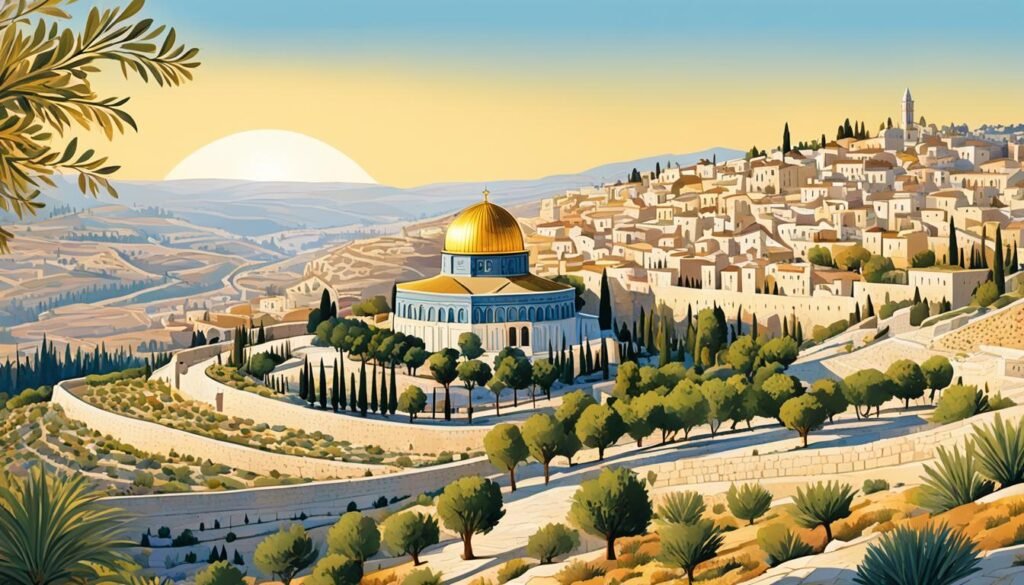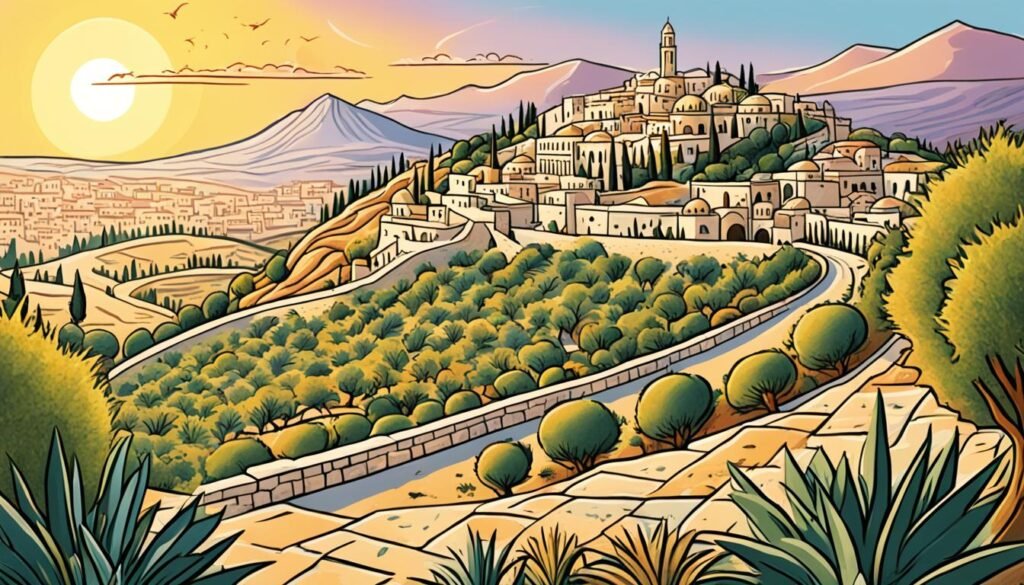According to biblical accounts, Jesus ascended to heaven from a mountain. The exact mountain is a subject of debate and interpretation among different sources. The Mount of Olives is commonly regarded as the mountain from which Jesus ascended, and it holds significant religious importance for Judaism, Christianity, and Islam.
Key Takeaways:
- The Mount of Olives is believed to be the mountain from which Jesus ascended to heaven.
- It is mentioned several times in the Bible and holds great historical and cultural significance.
- The location of the Ascension has been debated, but the Mount of Olives is widely accepted as the site.
- The Mount of Olives is a pilgrimage site for Christians, Jews, and Muslims alike.
- Regardless of the exact location, the Ascension represents Jesus’ return to heaven and is a pivotal event in Christian theology.
The Mount of Olives in Biblical Texts
The Mount of Olives plays a significant role in several biblical texts, particularly in relation to Jesus and important events in his life. It is prominently mentioned as the starting point for Jesus’ entry into Jerusalem and his final week leading up to the Crucifixion.
“And when he had said these things, he went on ahead, going up to Jerusalem. And when he drew near to Bethphage and Bethany, at the mount that is called Olivet, he sent two of the disciples” (Luke 19:28-29).
Additionally, the Mount of Olives is closely associated with the Garden of Gethsemane, where Jesus went to pray before his arrest. The garden, located on the slopes of the Mount of Olives, holds profound significance in biblical accounts:
“And when they came to a place called Gethsemane, he said to his disciples, ‘Sit here while I pray.'” (Mark 14:32)
Furthermore, the Mount of Olives is explicitly mentioned as the location of Jesus’ Ascension into heaven in the book of Acts:
“And when he had said these things, as they were looking on, he was lifted up, and a cloud took him out of their sight. And while they were gazing into heaven as he went, behold, two men stood by them in white robes, and said, ‘Men of Galilee, why do you stand looking into heaven? This Jesus, who was taken up from you into heaven, will come in the same way as you saw him go into heaven.'” (Acts 1:9-11)
Significance in the Life of Jesus
The Mount of Olives holds immense importance in the life and ministry of Jesus. It served as a significant setting for his entry into Jerusalem, his prayers in the Garden of Gethsemane, and his final moments before the Ascension. These biblical references highlight the Mount of Olives as a sacred and pivotal location in the life of Jesus.
Historical and Cultural Significance of the Mount of Olives
The Mount of Olives holds immense historical and cultural significance, making it a revered site for people of various faiths. For centuries, it has been a sacred burial ground in Judaism, believed to be the starting point of the messianic era. This ancient Jewish tradition highlights the mountain’s spiritual importance and its role in the future redemption of mankind.
Since the 4th century CE, the Mount of Olives has also been an integral part of Christian history. Over the years, numerous churches and shrines representing different denominations have been built on its slopes. These architectural wonders stand as testaments to the mountain’s role in biblical events and continue to attract Christian pilgrims from around the world.
The Mount of Olives is a symbol of our collective religious heritage, a place where believers from various traditions come together to pay homage to their shared spiritual legacy.
In addition to its significance for Judaism and Christianity, the Mount of Olives holds cultural importance for Islam. Many Muslims believe that it is the site from which the Prophet Muhammad ascended to heaven during his Night Journey. A joint mosque and Christian chapel exist on the mountain, serving as a representation of the shared reverence for this sacred place among Muslims and Christians.

Historical and Cultural Significance of the Mount of Olives
| Religion | Significance |
|---|---|
| Judaism | Sacred burial ground and believed starting point of the messianic era |
| Christianity | Home to various churches and shrines representing different denominations |
| Islam | Believed to be the place from which the Prophet Muhammad ascended to heaven |
The historical and cultural significance of the Mount of Olives extends far beyond its physical presence. It represents a shared heritage and serves as a bridge between different religious traditions. Whether it be through burial rituals, prayer, or pilgrimage, the Mount of Olives continues to inspire and unite believers from diverse backgrounds.
Geographical Features of the Mount of Olives
The Mount of Olives is a remarkable geographical feature located just east of the Old City of Jerusalem. This multi-summit limestone ridge offers stunning views of the city and serves as a symbolic gateway to Jerusalem’s rich religious history.
The Mount of Olives is separated from the city by the picturesque Kidron Valley, adding to its distinct character and allure.
The highest peak on the Mount of Olives, known as Mount Scopus, rises proudly at approximately 2,694 feet (820 meters) above sea level. Its commanding presence makes it an iconic landmark visible from various parts of Jerusalem.
The middle peak of the Mount of Olives is graced by the majestic Augusta Victoria Hospital. This prominent structure not only serves as a medical institution but also stands as a testament to the enduring significance of the Mount of Olives in the region.
The southern summit, referred to as the Mount of Olives proper, reaches an elevation of 2,652 feet (808 meters) above sea level, offering visitors an awe-inspiring panorama of the surrounding landscapes.
To truly appreciate the beauty and grandeur of the Mount of Olives, one needs to experience the breathtaking views it offers firsthand.
| Geographical Features | Elevation (feet) |
|---|---|
| Mount Scopus (highest peak) | 2,694 |
| Augusta Victoria Hospital (middle peak) | — |
| Mount of Olives proper (southern summit) | 2,652 |
The Mount of Olives in Jewish Tradition
In Jewish tradition, the Mount of Olives holds deep significance and is considered a sacred site. It is believed to be the location of the resurrection and the place from which the messiah will defend Israel in the future, as mentioned in Zechariah 14:4. The Mount of Olives is also associated with the departure and return of the Glory of the Lord, as described in the book of Ezekiel. For the Jewish people, it is the most sacred burial ground in Judaism.
The Mount of Olives is steeped in religious and historical importance, representing a connection to the divine and serving as a space for reflection and reverence. It is a testament to the rich heritage and enduring traditions of the Jewish faith.
Throughout history, the Mount of Olives has been a place of pilgrimage and spiritual significance for Jewish communities around the world. It embodies the continuity of Jewish faith and the profound impact of biblical teachings. The strong historical and cultural ties to the Mount of Olives make it an important symbol and beacon of Jewish identity.
Interpretations of the Ascension Location
Different sources and interpretations suggest various locations for Jesus’ Ascension. While the Mount of Olives is widely accepted as the site of the Ascension, some references mention Bethany as the place from which Jesus ascended. The proximity of Bethany to the Mount of Olives, along with the geographical relationship between the two, may explain the use of both locations in biblical texts. The Church of Pater Noster on the Mount of Olives is believed by many to be the authentic site of the Ascension.
Geographical Relationship between the Mount of Olives and Bethany
The Mount of Olives and Bethany are located in close proximity to each other, which has led to differing interpretations of the Ascension location. The Mount of Olives lies just east of Jerusalem, while Bethany is situated on the southeastern slope of the Mount of Olives. The significance of these neighboring locations in biblical events has sparked debates among scholars and religious authorities.
According to Luke 24:50-51 (New International Version), “When he had led them out to the vicinity of Bethany, he lifted up his hands and blessed them. While he was blessing them, he left them and was taken up into heaven.”
This biblical passage suggests that Jesus ascended from the vicinity of Bethany. However, other references, such as Acts 1:12 (New Living Translation), mention the Mount of Olives as the site of the Ascension.
The Church of Pater Noster
The Church of Pater Noster, located on the Mount of Olives, holds significance in relation to the Ascension location. This church is believed by many to be the place where Jesus taught the Lord’s Prayer (Our Father) and ascended into heaven. It is a major pilgrimage site for Christians who seek to connect with the events of Jesus’ life and witness the possible site of the Ascension.
Summary of Interpretations
The interpretations of the Ascension location reflect the diversity of biblical sources and historical perspectives. While the Mount of Olives remains the widely accepted location, the reference to Bethany introduces a compelling alternative. The Church of Pater Noster adds further weight to the authenticity of the Mount of Olives as the Ascension site. Ultimately, the exact location may remain a subject of interpretation, but the significance of the Ascension event itself transcends geographical boundaries.
Historical Events and Customs on the Mount of Olives
The Mount of Olives has been witness to numerous historical events throughout the centuries. One significant event took place in 1918 when the cornerstone of the Hebrew University was laid on Mount Scopus. This marked the beginning of the construction of various buildings, including the prestigious Jewish National and University Library and the renowned Rothschild-Hadassah University Hospital. These institutions have contributed significantly to education, research, and healthcare in Jerusalem and beyond.
In addition to its involvement in historical events, the Mount of Olives has also held great importance in Jewish customs and traditions. The hilltops of the Mount of Olives served as a unique location for the Jewish calendar. Fires would be lit on these hilltops, signaling the start of the new month for the Jewish people. This practice symbolized the beginning of important religious observances and festivities.
| Historical Events | Customs |
|---|---|
| 1918: Cornerstone of the Hebrew University laid on Mount Scopus | Fires lit on the Mount of Olives to announce the start of the new month |
| Construction of the Jewish National and University Library | |
| Establishment of the Rothschild-Hadassah University Hospital |

As the Mount of Olives continues to hold historical and cultural significance, these events and customs highlight the enduring importance of this unique location.
Impact of the Mount of Olives in Christianity
The Mount of Olives holds profound significance in Christianity, leaving an indelible impact on the faith. It is closely associated with pivotal events in the life of Jesus and serves as a spiritual destination for believers seeking to connect with their religious heritage and deepen their faith.
One of the most notable events linked to the Mount of Olives is Jesus’ triumphant entry into Jerusalem. As recorded in the Gospels, Jesus rode into the holy city on a donkey, while crowds greeted him with shouts of joy and laid palm branches in his path. This event, known as the Triumphal Entry or Palm Sunday, marks the beginning of the final week of Jesus’ earthly ministry and sets the stage for the momentous events that unfold.
Another significant site on the Mount of Olives is the Church of Pater Noster, where Jesus is believed to have taught his disciples the Lord’s Prayer. This sacred space serves as a tangible reminder of Jesus’ teachings and resonates with worshippers seeking to better understand and embody the principles laid out in this foundational Christian prayer.
Our Father in heaven, hallowed be your name, your kingdom come, your will be done, on earth as it is in heaven…
Perhaps the most impactful event associated with the Mount of Olives is Jesus’ Ascension into heaven after his resurrection. According to the biblical account, Jesus gathered his disciples on the Mount of Olives, imparted final instructions, and then ascended into heaven, disappearing from their sight. This pivotal moment marked the conclusion of Jesus’ earthly ministry and affirmed his divinity, sparking hope and faith in the hearts of believers for generations to come.
The Mount of Olives stands as a constant reminder of the immense sacrifice and love demonstrated by Jesus, uniting Christians in their reverence for the Son of God. It serves as a pilgrimage site, drawing believers from all corners of the globe who seek to walk in the footsteps of Jesus, reflect on his teachings, and experience the profound spiritual impact of the Mount of Olives.
Christian Sites on the Mount of Olives
| Site | Significance |
|---|---|
| Church of All Nations | Commemorates Jesus’ agony in the Garden of Gethsemane |
| Church of Dominus Flevit | Marked by a teardrop-shaped church, it signifies Jesus’ weeping over Jerusalem |
| Church of Mary Magdalene | Dedicated to Mary Magdalene, one of Jesus’ closest followers |
| Russian Orthodox Church of the Ascension | Believed by the Russian Orthodox community to be the exact location of Jesus’ Ascension |
| Church of the Ascension | A joint Muslim and Christian site commemorating the Ascension of Jesus |
Importance of the Mount of Olives in Islam
The Mount of Olives holds great significance in Islam, as it is believed to be one of the places where the Prophet Muhammad prayed during his Night Journey from Mecca to Jerusalem. This sacred mountain is deeply cherished by Muslims, who recognize its historical and spiritual importance.

One of the notable sites near the Mount of Olives is the Chapel of the Ascension, which attracts visitors from the Islamic faith. Pilgrims come to honor the Prophet Muhammad’s connection to the area and to offer their prayers in this revered location.
“The Mount of Olives holds a special place in the hearts of Muslims who deeply value its role in the Prophet Muhammad’s spiritual journey.”
The Mount of Olives serves as a tangible link to the Prophet’s legacy, allowing Muslims to connect with his life and teachings. It serves as a reminder of the rich history of Islam and the profound significance of Jerusalem in the Muslim faith.
Controversies and Debates Surrounding the Ascension Location
The exact location of Jesus’ Ascension has sparked ongoing debates and controversies throughout history. While many religious traditions point to the Mount of Olives as the site of this significant event, other sources mention alternative locations, such as Bethany. These discrepancies in location descriptions have led to differing opinions among scholars and religious authorities, adding to the ongoing debates surrounding the Ascension location.
Ultimately, it is important to recognize that the controversies and debates surrounding the Ascension location stem from the limitations of historical documentation and the interpretation of biblical texts. The significance of the Ascension lies not in pinpointing the exact geographical location, but in its profound spiritual and theological meaning. The Ascension represents Jesus’ return to the heavenly realm and holds deep symbolic importance in Christian beliefs.
“While the Ascension location remains a matter of theological debate, its spiritual significance remains unquestionable.”
These controversies and debates serve as a reminder of the diversity of interpretations within religious traditions and the complex nature of historical research. They encourage scholars and believers to delve deeper into the texts, seeking a greater understanding of the Ascension and its theological implications, rather than finding a definitive answer to the location question.
The ongoing discourse surrounding the Ascension location emphasizes the importance of dialogue, open-mindedness, and respectful consideration of differing viewpoints. It also fosters a deeper appreciation for the multifaceted nature of religious faith and the ways in which beliefs can shape interpretations and understanding.
In the next section, we will explore the impact of the Mount of Olives in various religious traditions and the significance it holds for pilgrims and worshippers.
Please note: The image above is for illustrative purposes only and does not depict a specific controversy or debate surrounding the Ascension location.
Pilgrimages and Worship on the Mount of Olives
The Mount of Olives is a sacred destination that attracts pilgrims from various religious backgrounds. It serves as a place of prayer, reflection, and spiritual connection for believers from around the world. Whether it’s Christians seeking to walk in the footsteps of Jesus or Jews honoring their sacred burial traditions, the Mount of Olives offers a profound experience of worship and devotion.
Christian worship services are held in churches and chapels scattered across the Mount of Olives. These services provide a space for believers to gather, offer prayers, and seek solace in the heart of Jerusalem. With its historical significance in the life of Jesus, the Mount of Olives holds a special place in Christian worship, allowing followers to connect with their faith on a deeper level.
“Walking through the ancient olive trees, one can feel a sense of awe and reverence. The tranquility and beauty of the surroundings create an atmosphere conducive to prayer and contemplation.”
– Reverend Michael Johnson, The Church of Pater Noster
In Jewish tradition, the Mount of Olives functions as a sacred burial ground dating back centuries. Many Jews choose to be buried in the cemetery on the Mount of Olives, believing it to be a holy resting place. Burial ceremonies are conducted with reverence and respect, allowing families and communities to bid farewell to their loved ones while adhering to their religious customs.
The Mount of Olives embodies the essence of pilgrimage, offering a space where people can reconnect with their faith, pay homage to their religious heritage, and find solace in the presence of divine power. It serves as a testament to the enduring power of worship and the human need for spiritual connection.
| Religious Tradition | Activities |
|---|---|
| Christianity |
|
| Judaism |
|
A group of pilgrims reflecting and praying on the Mount of Olives
Conclusion
The Mount of Olives holds a central place in the religious history and beliefs of Judaism, Christianity, and Islam. Although the exact mountain from which Jesus ascended remains a matter of interpretation, the Mount of Olives is widely regarded as the location for this significant event. With its geographical features, historical significance, and cultural importance, the Mount of Olives attracts pilgrims from around the world who seek to engage in worship, reflection, and spiritual connection.
The Mount of Olives serves as a pilgrimage site where believers can explore the biblical events associated with Jesus, including his entry into Jerusalem, teachings at the Church of Pater Noster, and Ascension into heaven. Its sacredness is reflected in the various churches, shrines, mosques, and burial grounds that have been constructed over the centuries, representing the diverse religious traditions and beliefs tied to this holy site.
The Ascension of Jesus holds profound theological significance in Christianity, symbolizing his return to the heavenly realm and the promise of his eventual second coming. Regardless of the ongoing debates about the specific location, the spiritual and theological meaning of the Ascension transcends geographic details, inviting believers to contemplate the divine mystery and embrace the hope and faith it inspires.
FAQ
What mountain did Jesus ascend from?
According to biblical accounts, Jesus ascended to heaven from a mountain. The exact mountain is a subject of debate and interpretation among different sources.
What is the significance of the Mount of Olives in biblical texts?
The Mount of Olives is mentioned several times in the Bible, particularly in relation to Jesus and significant events in his life. It is referred to as the starting point for Jesus’ entry into Jerusalem and his final week before the Crucifixion. The Garden of Gethsemane, where Jesus prayed before his arrest, is located on the slopes of the Mount of Olives. Additionally, the Mount of Olives is mentioned as the place of Jesus’ Ascension into heaven in the book of Acts.
What is the historical and cultural significance of the Mount of Olives?
The Mount of Olives holds great historical and cultural significance. It has been a sacred burial ground in Judaism for centuries, as ancient Jewish tradition states that the messianic era will begin there. Since the 4th century CE, various Christian churches and shrines have been built on the Mount of Olives, representing different denominations. Furthermore, a joint mosque and Christian chapel exist on the site where many Christians and Muslims believe Jesus ascended into heaven.
What are the geographical features of the Mount of Olives?
The Mount of Olives is a multi-summit limestone ridge located just east of the Old City of Jerusalem. It is separated from the city by the Kidron Valley. The highest peak, commonly known as Mount Scopus, stands at approximately 2,694 feet (820 meters) above sea level. The middle peak is crowned by the Augusta Victoria Hospital, while the southern summit, regarded as the Mount of Olives proper, reaches 2,652 feet (808 meters) above sea level.
What is the significance of the Mount of Olives in Jewish tradition?
The Mount of Olives holds deep significance in Jewish tradition. It is believed to be the site of the resurrection and the place from which the messiah will defend Israel in the future, as mentioned in Zechariah 14:4. Additionally, the Mount of Olives is associated with the departure and return of the Glory of the Lord, as described in the book of Ezekiel. The Jewish people consider it the most sacred burial ground in Judaism.
What are the different interpretations of the location of the Ascension?
Different sources and interpretations suggest various locations for Jesus’ Ascension. While the Mount of Olives is widely accepted as the site of the Ascension, some references mention Bethany as the place from which Jesus ascended. The proximity of Bethany to the Mount of Olives, along with the geographical relationship between the two, may explain the use of both locations in biblical texts.
What historical events and customs are associated with the Mount of Olives?
The Mount of Olives has played a role in numerous historical events. In 1918, the cornerstone of the Hebrew University was laid on Mount Scopus, with various buildings, including the Jewish National and University Library and the Rothschild-Hadassah University Hospital, being constructed over the years. The Mount of Olives also served as a significant location for the Jewish calendar, with fires being lit on its hilltops to signal the start of the new month.
How does the Mount of Olives impact Christianity?
The Mount of Olives has profound significance in Christianity. It is associated with several key events in the life of Jesus, including his entry into Jerusalem, his teachings at the Church of Pater Noster, and his Ascension into heaven. The Mount of Olives serves as a pilgrimage site for Christians from around the world who come to connect with the religious history and experience the spirituality of the place.
What is the importance of the Mount of Olives in Islam?
The Mount of Olives also holds significance in Islam. It is believed to be one of the places where the Prophet Muhammad prayed during his Night Journey from Mecca to Jerusalem. The Chapel of the Ascension, a Muslim site located near the Mount of Olives, attracts visitors from the Islamic faith who come to honor the Prophet’s connection to the area.
What are the controversies and debates surrounding the location of the Ascension?
The exact location of Jesus’ Ascension has been a topic of debate and controversy over the centuries. While many traditions point to the Mount of Olives, some sources mention other sites, including Bethany. These discrepancies in location descriptions have led to differing opinions among scholars and religious authorities.
What is the significance of the Mount of Olives for pilgrimages and worship?
The Mount of Olives attracts pilgrims from various religious backgrounds who come to offer prayers, reflect on the biblical events associated with the place, and connect with their faith. Christian worship services are held at churches and chapels on the Mount of Olives, while Jewish traditions include burial ceremonies in the sacred cemetery. The Mount of Olives serves as a site for personal and communal expressions of devotion and spirituality.
What is the conclusion about the Ascension location?
The identity of the precise mountain from which Jesus ascended may remain a matter of interpretation, but the Mount of Olives holds a central place in the religious history and beliefs of Judaism, Christianity, and Islam. Its geographical features, historical significance, and cultural importance make it a significant site for pilgrimage, worship, and spiritual reflection. Regardless of the exact location, the Ascension of Jesus remains a pivotal event in Christian theology, representing his return to the heavenly realm and the promise of his eventual second coming.
Source Links
- https://www.britannica.com/place/Mount-of-Olives
- https://catholicconvert.com/did-jesus-ascend-into-heaven-from-mount-of-olives-acts-112-or-from-bethany-luke-2450/
- https://www.fbcaltoona.org/site/handlers/filedownload.ashx?moduleinstanceid=332&dataid=731&FileName=David_New_-_Why_Did_Jesus_Ascend_From_The_Mount_of_Olives.pdf

I’m Benjamin, a passionate spiritual seeker and creator of Verses and Prayers. Alongside my girlfriend Emma and our pet lizard Mulle, I cherish family life, enjoy exploring new places, and am deeply involved in my church community. My love for reading and singing biblical verses inspires every aspect of my journey.

